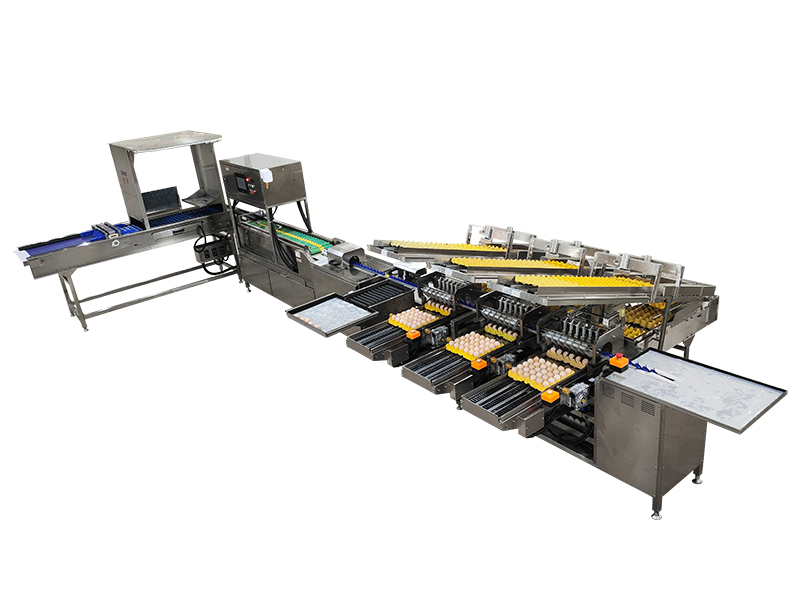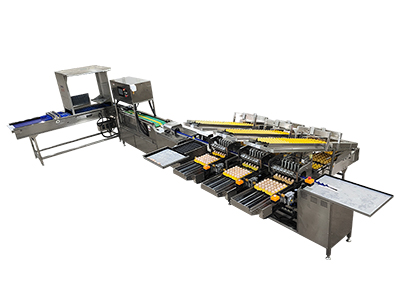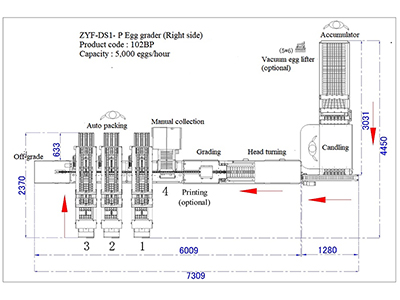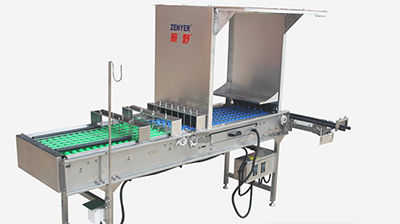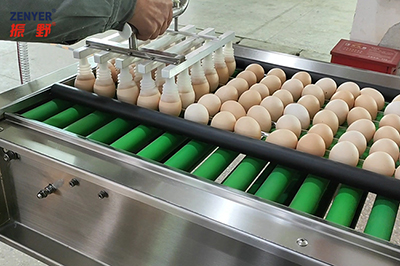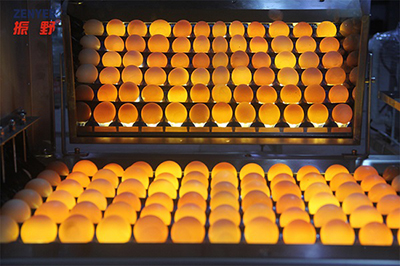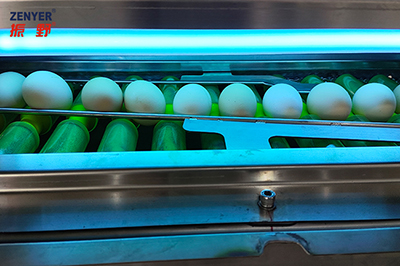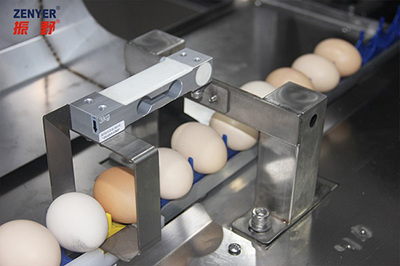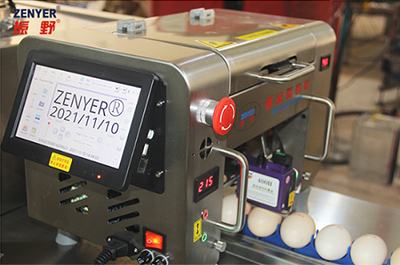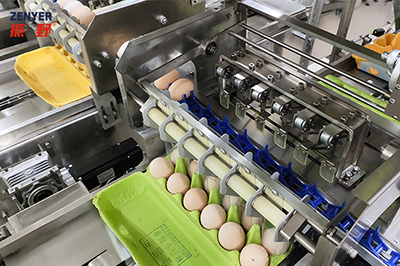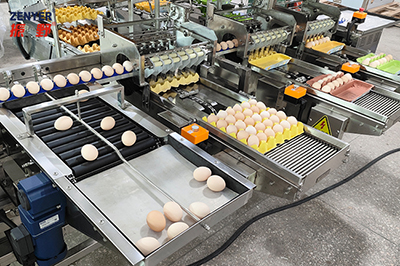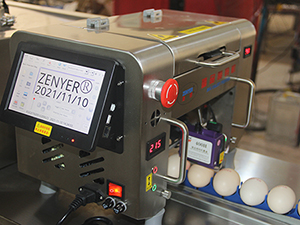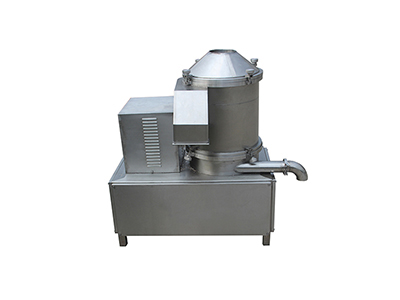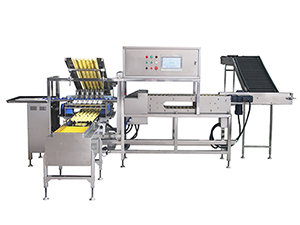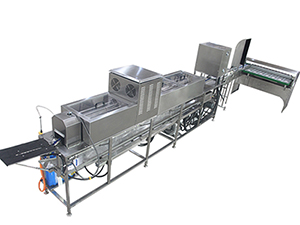- Home
- Products
- Egg Grader
- 102BP Egg Grader
102BP Egg Grader (5,000 EGGS/HOUR)
Designed for small to medium-sized free-range egg farms, this egg grading equipment offers a production capacity of 5000 eggs per hour. It integrates several functions, including egg accumulating, LED light inspection, automatic egg turning, electronic grading, counting, and automatic packing, all within a compact and well-engineered design. Operating efficiently with just two operators, one handles egg loading and inspection, while the other manages the empty trays and collects the filled egg trays.
The automatic egg packer accommodates both 12-egg cartons and 30-egg trays. A color PLC touchscreen allows operators to easily adjust grading weights and other parameters, providing convenience and speed. The intelligent self-diagnosis function displays fault causes on the screen when issues arise, helping users quickly identify and resolve problems.
Additionally, the egg grader connects seamlessly to the Zenyer 201A egg washer, forming the ZENYER 301AP egg processing line with a capacity of 5000 eggs per hour.
| Name | Egg grader |
| Product code | 102BP |
| Model | ZYF-DS1-P |
| Capacity | 5,000 eggs/hour |
| Accuracy | ±1 gram |
| Grade | 4~5 |
| Main material | Stainless steel |
| Power | 3.6KW |
| Voltage | 220~240V, 50Hz, single phase Or 380~415V, 50HZ, 3-phase |
| Dimension (L*W*H) | 7.3*4.4*2 M |
| Net weight | 960KG |
| Gross weight | 1380KG |
| Functions | Egg accumulating & candling, automatic egg turning, electronic grading & counting, auto-packing, manual collection, optional UV sterilization, visual AI detector, egg printer and vacuum egg lifter |
- Accumulating
- Manual loading/Vacuum egg lifting (optional)
- Candling
- UV sterilization (optional)
- Automatic egg turning
- Visual AI detector(optional)
- Grading & Counting
- Egg printing (optional)
- Auto packing
- Manual collection
The Zenyer 605A accumulator is equipped with a modular belt conveyor or roller conveyor (depending on your situation and requirements), a 6-row LED light inspection, and a six-row-to-single-row orientator, making it a comprehensive solution for egg handling. It is designed to connect with single-row egg graders or egg washers with capacities of 5000 or 10,000 eggs per hour, facilitating both egg loading and inspection. The 6-lane design allows users to perform egg loading and inspection efficiently, with eggs transitioning from six rows to a single row before moving onto the rollers of the single-row egg graders or egg washers.
This accumulator also features a speed controller, allowing the adjustment of its speed to match the connected equipment, ensuring smooth and synchronized operation.
Manual egg loadingEgg loading with the vacuum egg lifter (optional)
The LED light inspection unit is installed beneath the 6-row rollers. As eggs pass over the rollers, the LED light illuminates them, allowing operators to visually identify and manually remove defective eggs, such as cracked, misshapen, dirty, or black-spotted eggs. The rollers are equipped with forced rotation bars that ensure continuous rolling of the eggs, providing a comprehensive view during inspection.
The egg candling device includes a candling hood and mirror, enabling operators to see the backside of the eggs, eliminating visual blind spots for a more thorough inspection. Additionally, curtains are installed at the front and rear of the candling hood, which can be drawn to create a darkened environment, enhancing the effectiveness of the LED inspection process.
The UV sterilization device is installed above the automatic egg turning section, ensuring that eggs undergo thorough disinfection as they are processed. This ultraviolet sterilization feature effectively sanitizes the eggshells, significantly reducing the risk of contamination and enhancing overall food safety.
As the eggs pass through the specially designed turning mechanism, they are automatically oriented to ensure that the larger end (the air cell) faces upwards after being packaged. This orientation is critical for extending the shelf life of the eggs, as it helps maintain the integrity of the air cell and keeps the egg fresher for a longer period. This automatic process not only enhances storage longevity but also ensures that the eggs are presented in the optimal position for quality preservation.
The Visual AI detector features a non-contact design, allowing operators to scan eggs without direct handling, thereby significantly enhancing food safety and hygiene. This advanced system is equipped with self-learning capabilities, meaning it continually adapts to new standards and requirements by accumulating data and updating its algorithms. Leveraging big data technology, the system learns from a vast repository of historical data, which boosts the accuracy and efficiency of egg detection.
The inspection process utilizes near-infrared (NIR) light and image processing to automatically detect any defects. As the eggs rotate on the feeding rollers, a camera mounted at the top of the cabinet scans them. The NIR light strip beneath the rollers enhances image clarity, allowing the camera to capture detailed visuals that are then processed by the computer. Eggs with cracked shells, dirt spots, or any other non-compliant features are automatically identified and removed from the processing line, ensuring only high-quality eggs proceed further.
As eggs enter the grading process, they are sorted into 4 to 5 weight categories with a grading accuracy of ±1 gram. The grader is also equipped with a counting function, which records the number of eggs in each grade, as well as the total number processed per shift, per day, and overall production output.
The machine features a color PLC touchscreen, allowing operators to easily modify grading weights and other parameters directly on the screen for quick and convenient adjustments. Additionally, the grader is equipped with a unique intelligent self-diagnosis function that displays fault causes on the screen when issues arise, helping users quickly identify and resolve problems.
Furthermore, this grader is equipped with Wi-Fi capabilities, enabling remote monitoring and diagnostics via the internet. If a software issue occurs, it can be quickly addressed and resolved through remote access, minimizing downtime and ensuring continuous operation.
The Zenyer 401H egg printer with 1 print head can be mounted on the single-row egg graders and egg washers. The printer is activated by a photoelectric sensor as the eggs pass underneath, triggering the printing process.
This printer is capable of printing text, numbers, logos, and dates on the eggs, which enables traceability of the eggs' origin. This traceability reassures consumers by providing them with information that guarantees the quality and safety of the eggs.
The standard configuration of the 102BP egg grader includes three automatic egg packers, each auto packer comes along with an inclined angle tray loader and a loaded egg tray collection conveyor, and one manual collection table for manual collection as well. After grading, eggs are automatically sorted by weight and packaged into the corresponding lanes’ egg cartons and egg trays. This grader is compatible with 12-egg cartons and 30-egg trays, with each automatic packer dedicated to packaging a specific grade of eggs.
In addition to the eggs that are automatically packaged, other eggs fall into the manual collection lane. This manual collection lane can be divided into two sections if needed, allowing it to accommodate two different weight categories.
Eggs that are too large or too small are directed to the reject table at the rear of the machine, where they are separated for further handling.
Shenzhen ZENYER Egg Machinery Co., Ltd.
Add.: 136, Jiangshi Road, Matian Street, Guangming District, Shenzhen 518106, China
Tel.: +86-755-26974700 / 26974701
Fax: +86-755-26974358
Email: office@zenyer.cn
WhatsApp: +86-13823737025
Wechat: +8618038158337
+8618018763375

